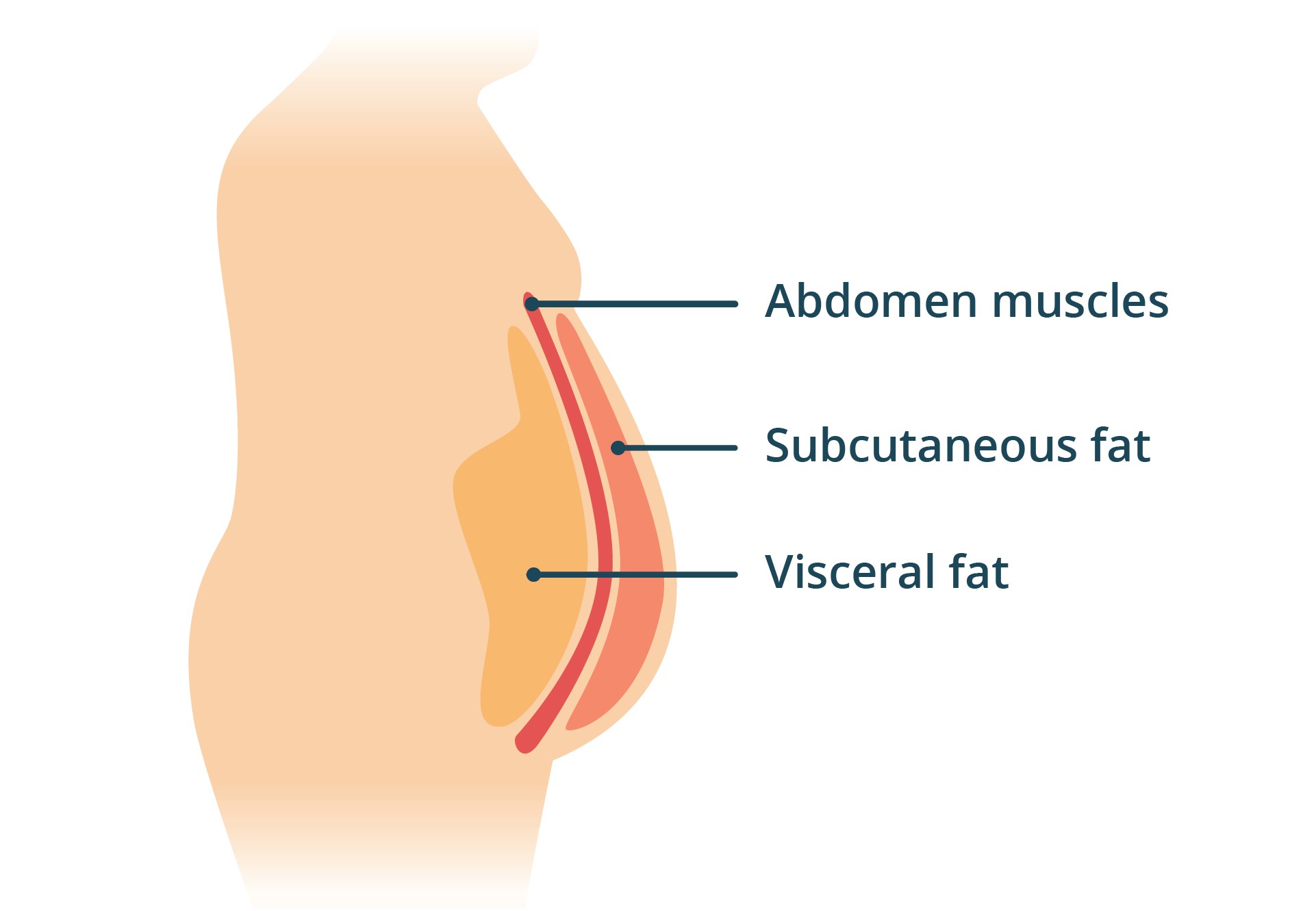Visceral fat, often referred to as ‘toxic fat,’ is a type of body fat that is stored deep within your abdominal cavity. Unlike subcutaneous fat, which lies just beneath the skin and is visible, visceral fat wraps around your internal organs, including the stomach, liver, intestines, and heart. This hidden location makes it particularly dangerous to your health.
Delving Deeper into Visceral Fat
While all body fat plays a role in energy storage, visceral fat is metabolically active, meaning it produces hormones and chemicals. However, visceral fat is known to release a higher quantity of inflammatory substances compared to subcutaneous fat. These substances can be toxic and disrupt normal bodily functions, significantly increasing the risk of serious health problems. It’s crucial to understand that while some visceral fat is normal and necessary to cushion organs, excess amounts can be detrimental. Interestingly, visceral fat is typically more prevalent in men than in women, although this can change after menopause in women.
 Diagram illustrating the location of visceral fat deep within the abdomen, surrounding vital organs.
Diagram illustrating the location of visceral fat deep within the abdomen, surrounding vital organs.
What Contributes to Visceral Fat Accumulation?
The primary driver of visceral fat accumulation is an imbalance between calorie intake and expenditure. When you consistently consume more calories than you burn through physical activity, your body stores the excess energy as fat. A portion of this stored fat can become visceral fat.
Several factors can increase an individual’s predisposition to storing excess calories as visceral fat:
- Gender: Men are generally more prone to accumulating visceral fat than pre-menopausal women.
- Menopause: Hormonal changes during menopause can shift fat storage patterns in women, leading to increased visceral fat.
- Genetics: Genetic predisposition can influence how your body stores and distributes fat, including visceral fat.
- Low Birth Weight: Individuals with a low birth weight may have a higher tendency to store visceral fat later in life.
- Excessive Alcohol Consumption: Regularly drinking too much alcohol can contribute to visceral fat buildup.
The Serious Health Risks Associated with Visceral Fat
Having excess visceral fat, particularly in the abdominal area (often termed ‘belly fat’), is a significant indicator of metabolic syndrome. Metabolic syndrome is a cluster of conditions occurring together that raise your risk of heart disease, stroke and type 2 diabetes. These conditions include high blood pressure, high blood sugar, excess body fat around the waist, and abnormal cholesterol or triglyceride levels.
Beyond metabolic syndrome, high levels of visceral fat are linked to an increased risk of:
- Cardiovascular Diseases: Including heart disease and stroke, due to the inflammatory substances released by visceral fat that can damage blood vessels and promote plaque buildup.
- Type 2 Diabetes: Visceral fat can contribute to insulin resistance, a hallmark of type 2 diabetes, where the body becomes less effective at using insulin to regulate blood sugar.
- Certain Cancers: Research suggests a link between higher visceral fat levels and an increased risk of certain cancers, such as colorectal and breast cancer.
- Non-Alcoholic Fatty Liver Disease (NAFLD): Visceral fat accumulation is closely associated with NAFLD, where excess fat builds up in the liver, potentially leading to liver damage.
- Alzheimer’s Disease and Dementia: Emerging studies indicate a potential link between visceral fat and an increased risk of cognitive decline and neurodegenerative diseases.
How to Determine if You Have Excess Visceral Fat
The most straightforward way to get an indication of your visceral fat level is by measuring your waist circumference. Your waist measurement is a practical estimate of the amount of fat stored deep within your abdomen, surrounding your organs.
You may be at a higher risk of chronic diseases if your waist circumference exceeds:
- 80cm (approximately 31.5 inches) for women
- 94cm (approximately 37 inches) for men
It’s important to note that these measurements are general guidelines for adults and may not apply to children or pregnant women. If you are concerned about your waist measurement, consulting with a healthcare professional is recommended.
Another tool that can be helpful is calculating your Body Mass Index (BMI). BMI provides an estimate of whether you are at a healthy weight for your height. While BMI doesn’t directly measure visceral fat, it can indicate overall body fat levels and potential risks associated with excess weight.
Strategies to Reduce Visceral Fat
The good news is that visceral fat is responsive to lifestyle modifications. The most effective approaches to reduce visceral fat involve:
- Weight Management: If you are overweight or obese, losing even a modest amount of weight (5-10% of your body weight) can significantly reduce visceral fat.
- Healthy Balanced Diet: Focus on a diet rich in whole, unprocessed foods, including fruits, vegetables, lean proteins, and whole grains. Limit your intake of sugary drinks, processed foods, and unhealthy fats.
- Regular Physical Activity: Exercise is particularly effective at targeting visceral fat. Aim for at least 150 minutes of moderate-intensity aerobic exercise or 75 minutes of vigorous-intensity aerobic exercise per week. Incorporating strength training exercises is also beneficial.
- Stress Management: Chronic stress can contribute to visceral fat accumulation. Practicing stress-reducing techniques like yoga, meditation, or spending time in nature can be helpful.
- Adequate Sleep: Getting enough quality sleep is crucial for overall health and can also influence visceral fat levels. Aim for 7-9 hours of sleep per night.
- Limit Alcohol Intake: Reducing or eliminating excessive alcohol consumption can help decrease visceral fat.
While genetic predisposition and hormonal factors play a role in body fat distribution, adopting a healthy lifestyle that prioritizes balanced nutrition and regular physical activity is key to managing and reducing visceral fat, thereby lowering your risk of associated health complications and promoting overall well-being.